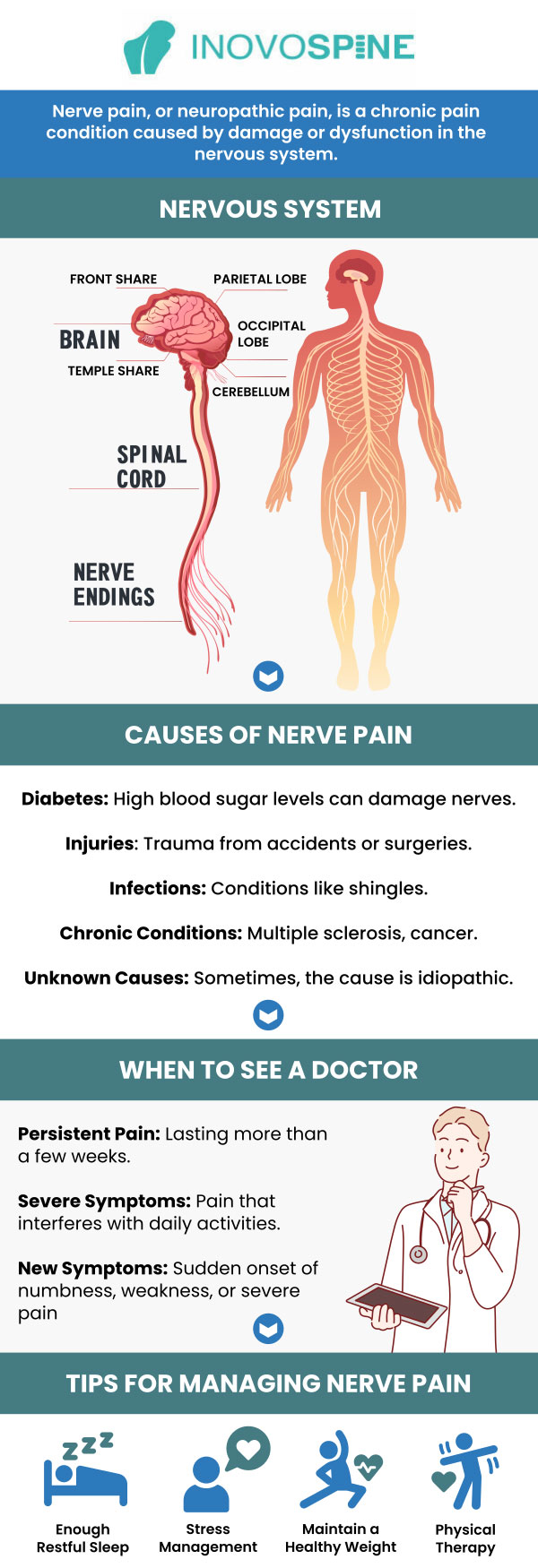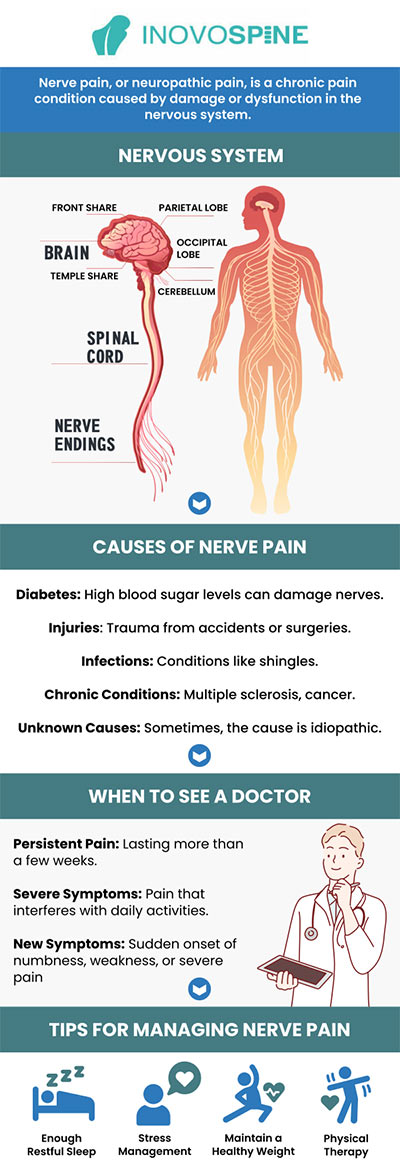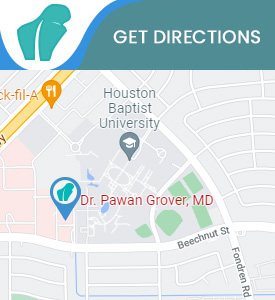Nerve Damage Treatment: Is It Possible to Heal Nerves?
At InovoSpine, Dr. Pawan Grover specializes in providing advanced care for patients dealing with the effects of nerve damage. While complete nerve healing may not always be possible, innovative treatments can often reduce symptoms, restore function, and improve quality of life. We use a personalized approach, combining cutting-edge therapies with compassionate care to address each patient’s unique condition. For more information, contact us or book an online appointment. We are conveniently located at 1140 Business Center Dr, Suite 110, Houston TX 77043.




Table of Contents:
Can damaged nerves heal on their own?
How long does it take for nerves to regenerate?
What are the signs that a nerve is healing?
What are the best treatments for nerve damage?
When nerves are damaged, their ability to heal depends on several factors, including the type of nerve, the extent of the injury, and its location—especially whether the injury is in the peripheral nervous system (nerves outside the brain and spinal cord) or involves the central nervous system (the spinal cord itself).
Peripheral nerves—such as those exiting the spine—do have some capacity to regenerate. If the nerve fiber (axon) is damaged but the protective sheath remains intact, these nerves can often regrow, sometimes at a rate of about one millimeter per day. Mild injuries, such as those caused by nerve compression or mild stretching (for example, from a herniated disc), may resolve on their own over time as the nerve recovers.
However, more severe injuries—such as when a nerve is completely severed or if the spinal cord itself is involved—are much less likely to heal naturally. In these cases, the body’s ability to repair or regenerate nerve tissue is minimal, and full recovery may not be possible without specialized medical intervention.
At Inovo Spine, we emphasize the importance of early diagnosis and treatment. Persistent symptoms should always be evaluated by a spine specialist. Our team uses advanced imaging and diagnostic tools to determine the cause of your symptoms and recommend the best treatment plan. Depending on the severity and nature of the nerve injury, we may recommend conservative approaches like physical therapy and medication, or advanced interventions including minimally invasive spine surgery.
Nerve regeneration is a gradual process influenced by the type and location of the injury, as well as your overall health. In particular, the peripheral nerves—which include many of the nerves affected by spine and back injuries—are capable of regeneration. Typically, these nerves regrow at about one millimeter per day, or roughly an inch per month. This means that recovery from nerve damage may take several months, depending on the distance between the injury and the area the nerve serves.
Following a nerve injury, the body works to clear out damaged nerve fibers at the injury site. New nerve fibers then begin to grow along the original pathway, assisted by supportive cells called Schwann cells. At Inovo Spine, our team monitors this process closely, as factors like your age, underlying health conditions (such as diabetes), and the quality of care you receive all play a role in how quickly and completely your nerves recover.
When injuries involve the central nervous system—such as the spinal cord—nerve regeneration is much more limited. While advances in medical science continue, recovery from spinal cord injuries is often slower and sometimes incomplete. However, we utilize the latest diagnostic tools, surgical techniques, and rehabilitation strategies to help maximize your potential for recovery.
During nerve regeneration, you may experience tingling, numbness, weakness, or other symptoms. Our multidisciplinary team provides comprehensive care, including physical therapy and rehabilitation, to help restore function and improve your quality of life. We also work with you to manage symptoms and monitor your progress throughout the healing process.
When a nerve is healing, you may notice a variety of changes depending on the type and location of your injury. One of the earliest signs is a gradual return of sensation in the affected area. Patients often describe this as a tingling or “pins and needles” feeling (paresthesia), which can evolve into more normal sensations. You might find that numbness begins to fade, and you can better distinguish between temperatures or textures.
As the nerve continues to recover, muscle strength in the affected region may slowly improve. This might begin with slight muscle twitches or small involuntary movements—encouraging signs that the nerve is regaining function. Over time, you may notice improved voluntary control of the muscles, making daily tasks easier and restoring your independence.
Many patients at Inovo Spine also report a reduction in pain, burning, or “electric shock” sensations as their nerves heal. While some discomfort is a normal part of recovery, persistent or worsening pain should be promptly evaluated by our medical team.
Improvements in coordination and fine motor skills—such as grasping small objects or buttoning a shirt—can further indicate that both sensory and motor nerves are on the mend. In cases involving autonomic nerves, you might observe changes in sweating patterns or skin color as healing progresses.
Nerve damage can be a challenging condition, but several treatments can help manage symptoms and promote healing. The best treatment options depend on the type, location, and severity of the nerve damage.
Medications: Pain management is often the first step. Over-the-counter pain relievers like ibuprofen or acetaminophen may be sufficient for mild cases. For more severe pain, doctors may prescribe medications like antidepressants (e.g., amitriptyline) or anticonvulsants (e.g., gabapentin), which are effective in treating nerve-related pain.
Physical Therapy: This helps restore movement and function by strengthening the muscles surrounding the damaged nerves. Specialized exercises can improve range of motion and alleviate discomfort.
Nerve Blocks or Injections: Corticosteroid injections or nerve blocks can be used to reduce inflammation and alleviate pain in the affected area.
Surgery: If the nerve damage is severe, surgery may be necessary. Procedures like nerve grafts, nerve transfers, or decompression surgery can help restore function by repairing or bypassing the damaged nerve.
Regenerative Medicine: Stem cell therapy and platelet-rich plasma (PRP) therapy are emerging treatments aimed at regenerating nerve tissue, although more research is needed to fully establish their efficacy.
Lifestyle Changes: Proper nutrition, including vitamins like B12, can support nerve health, as well as quitting smoking, managing blood sugar levels, and maintaining a healthy weight.
The best approach depends on individual circumstances, and a comprehensive treatment plan involving a combination of these options is often the most effective way to address nerve damage.
Visit Dr Pavan Grover for the treatment of your damaged nerve
Treatment at Inovo Spine often begins with conservative measures, including medication management to control nerve pain and inflammation, physical therapy to restore function and mobility, and lifestyle modifications to support optimal nerve healing. For patients who need additional relief, Dr. Grover utilizes interventional procedures such as targeted nerve blocks or minimally invasive injections, performed with advanced imaging guidance to precisely address pain and inflammation at the source.
For more persistent or severe cases of nerve damage, Inovo Spine offers cutting-edge regenerative medicine therapies like platelet-rich plasma (PRP) and stem cell treatments to encourage nerve repair and regeneration. When conservative therapies are not sufficient, Dr. Grover may recommend surgical solutions or advanced neuromodulation techniques, including spinal cord stimulation, which uses gentle electrical impulses to help manage chronic pain by blocking pain signals before they reach the brain.
Throughout your care at Inovo Spine, Dr. Grover is dedicated to a personalized approach. He works closely with each patient to develop a tailored treatment plan, always focused on optimizing recovery, restoring function, and improving quality of life. For more information, contact us or book an online appointment. We are conveniently located at 1140 Business Center Dr, Suite 110, Houston TX 77043. We serve patients from Houston TX, Hedwig Village TX, Meadows Place TX, Missouri City TX, Hunters Creek Village TX, Spring Valley Village TX, and surrounding areas.

Additional Service You May Need
- Regenerative Medicine
- Spinal Arthritis
- Diagnostic Mapping
- Interventional Pain
- Minimally Invasive
- Spine Pain
- Radiofrequency Ablation
- Spinal Cord Stimulation
- Physical Rehabilitation
- Facet Joint Pain
- Herniated Discs
- Muscle and Joint Pain
- Post-Laminectomy Pain
- Myofascial Pain
- Peripheral Nerve Pain
- Regional Pain Syndrome









